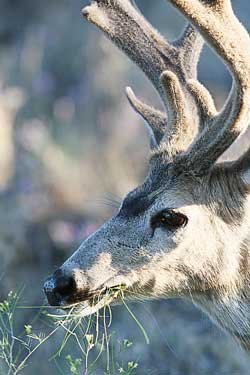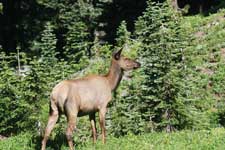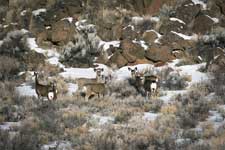 Heart-shaped prints in the soft sand betray the passing of a mule deer, one of the larger herbivores in the Deer family (Cervidae) that inhabits Canyon Country. Named for their large, mule-like ears, these deer are common across the western half of North America. Next to chipmunks, ground squirrels and rabbits, mule deer are probably the wildlife species that most folks see in the wild. It helps that herds of mule deer occur across a broad elevational range, migrating between lower elevation winter and higher elevation summer ranges during the year.
Heart-shaped prints in the soft sand betray the passing of a mule deer, one of the larger herbivores in the Deer family (Cervidae) that inhabits Canyon Country. Named for their large, mule-like ears, these deer are common across the western half of North America. Next to chipmunks, ground squirrels and rabbits, mule deer are probably the wildlife species that most folks see in the wild. It helps that herds of mule deer occur across a broad elevational range, migrating between lower elevation winter and higher elevation summer ranges during the year.
Though I see them often, I never tire of seeing these charismatic species. Their bounding gait as they run for cover, their stately antler racks, their ability to leap tall fences in a single bound, and their massive ears: these are the characteristics that define “mulies.”
Beginning in spring, mule deer bucks start to regrow antlers that were shed the previous season. Controlled by day length and testosterone, this fuels the antler cycle and primes the bucks for the mating season ahead.
Incorrectly referred to as “horns,” antlers are made of bone. They are branched, deciduous and generally only found on males, whereas horns are generally unbranched, permanent and have a keratin sheath around a bony core. Elk and deer have antlers; bighorn sheep and pronghorn bear horns, although pronghorns have unique horns.
During their early growth, antlers have spongy bone covered with hairy “velvet” that supplies blood and nutrients to the developing bone. As antlers form, the outer bone hardens while the inner has marrow spaces and softer bone. The process is like building a frame, then filling that frame with concrete. Eventually as the bone hardens, the velvet dries up and either falls or is rubbed off. Some bucks eat their velvet, recycling nutrients used in its production.

Bighorn sheep horns can be aged by their annual growth rings, but antlers cannot be aged. Although bucks normally grow antlers starting at one-and-a-half years old, they do not branch with each successive year of life. Oddly, the cells that form the antler bud, if removed and grafted onto the deer’s body, could regrow – creating a unicorn or a many-horned beast.
The growth of the antlers culminates prior to the mating or rutting season. During this time, bucks posture and fight with each other, attempting to impress the does. Sometimes the clatter of jousting antlers lures one towards this spectacle. The promiscuous bucks will mate with any female that accepts them; does may mate with more than one buck.
In early winter, the buck’s antlers drop off and these “sheds” provide food for rodents or treasures for “shed hunters.”

Mating occurs in late fall and females may produce a litter of one or two fawns in late spring or early summer. Triplets are very uncommon; younger does generally have a single fawn. Weighing around eight pounds at birth, the spotted fawns can walk a short time after birth. They have to - otherwise predators would take more fawns than they do. But movement isn’t the fawn’s only defense; their cryptic coat provides camouflage so they can hide from predators.
So as September lays its cooler blanket over Canyon Country, keep an eye out for the mulies as they engage in this ancient cycle of life and death.